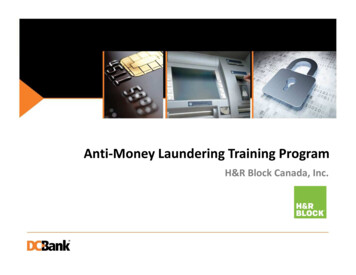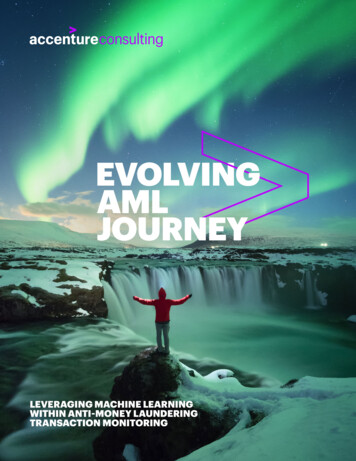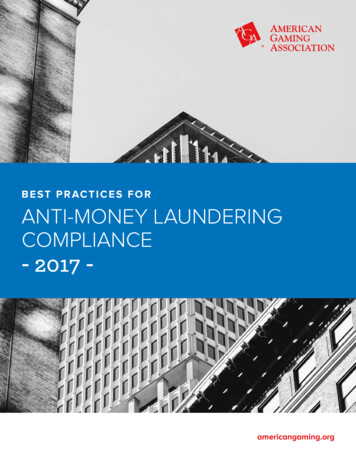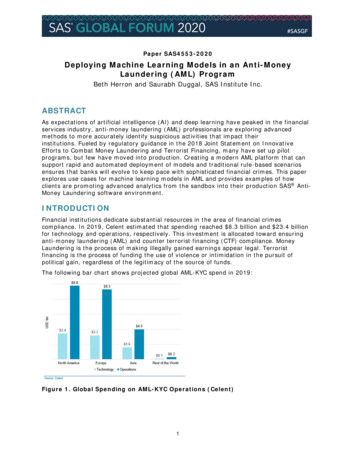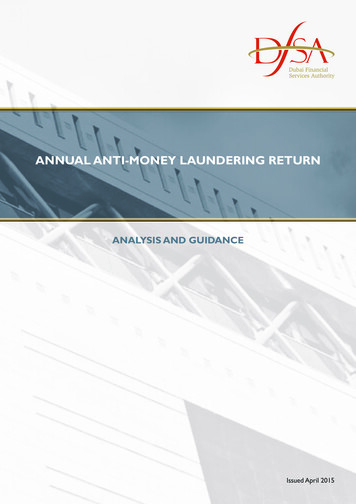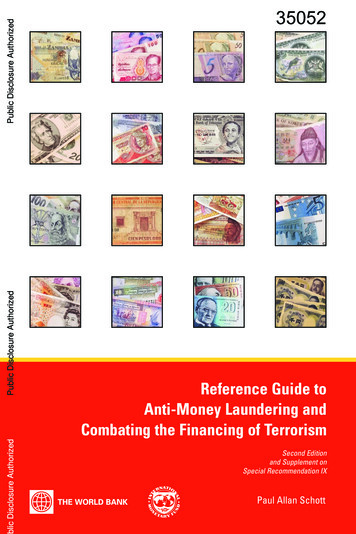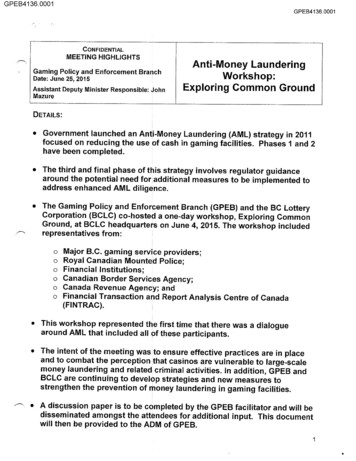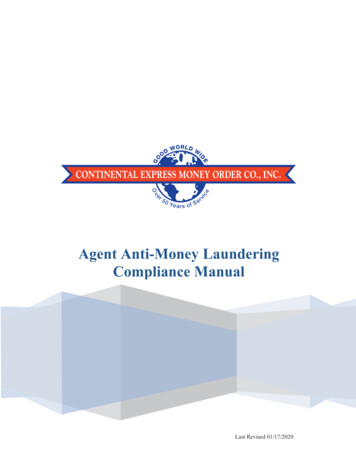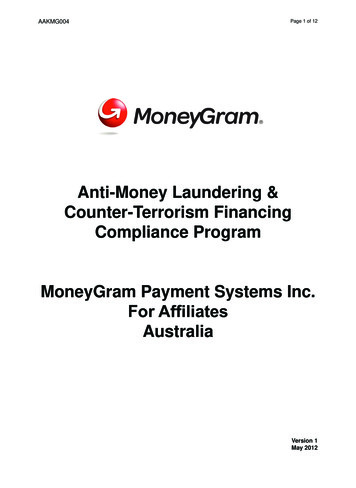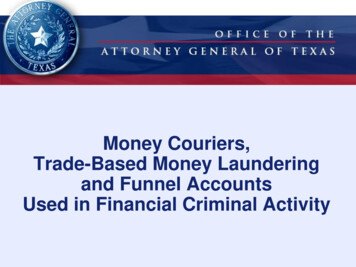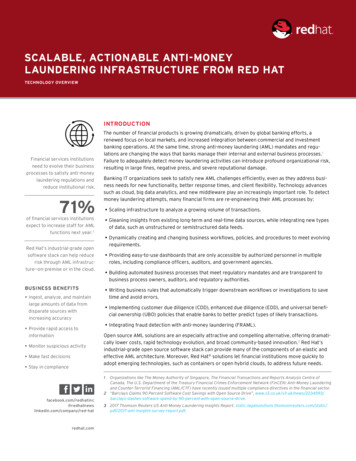
Transcription
SCALABLE, ACTIONABLE ANTI-MONEYLAUNDERING INFRASTRUCTURE FROM RED HATTECHNOLOGY OVERVIEWINTRODUCTIONFinancial services institutionsneed to evolve their businessprocesses to satisfy anti-moneylaundering regulations andreduce institutional risk.71%The number of financial products is growing dramatically, driven by global banking efforts, arenewed focus on local markets, and increased integration between commercial and investmentbanking operations. At the same time, strong anti-money laundering (AML) mandates and regulations are changing the ways that banks manage their internal and external business processes.1Failure to adequately detect money laundering activities can introduce profound organizational risk,resulting in large fines, negative press, and severe reputational damage.Banking IT organizations seek to satisfy new AML challenges efficiently, even as they address business needs for new functionality, better response times, and client flexibility. Technology advancessuch as cloud, big data analytics, and new middleware play an increasingly important role. To detectmoney laundering attempts, many financial firms are re-engineering their AML processes by: Scaling infrastructure to analyze a growing volume of transactions.of financial services institutionsexpect to increase staff for AMLfunctions next year. 3 Gleaning insights from existing long-term and real-time data sources, while integrating new typesof data, such as unstructured or semistructured data feeds.Red Hat’s industrial-grade opensoftware stack can help reducerisk through AML infrastructure — on-premise or in the cloud. Providing easy-to-use dashboards that are only accessible by authorized personnel in multipleroles, including compliance officers, auditors, and government agencies.BUSINESS BENEFITS Ingest, analyze, and maintainlarge amounts of data fromdisparate sources withincreasing accuracy Provide rapid access toinformation Monitor suspicious activity Make fast decisions Stay in compliance Dynamically creating and changing business workflows, policies, and procedures to meet evolvingrequirements. Building automated business processes that meet regulatory mandates and are transparent tobusiness process owners, auditors, and regulatory authorities. Writing business rules that automatically trigger downstream workflows or investigations to savetime and avoid errors. Implementing customer due diligence (CDD), enhanced due diligence (EDD), and universal beneficial ownership (UBO) policies that enable banks to better predict types of likely transactions. Integrating fraud detection with anti-money laundering (FRAML).Open source AML solutions are an especially attractive and compelling alternative, offering dramatically lower costs, rapid technology evolution, and broad community-based innovation. 2 Red Hat’sindustrial-grade open source software stack can provide many of the components of an elastic andeffective AML architecture. Moreover, Red Hat solutions let financial institutions move quickly toadopt emerging technologies, such as containers or open hybrid clouds, to address future needs.Organizations like The Money Authority of Singapore, The Financial Transactions and Reports Analysis Centre ofCanada, The U.S. Department of the Treasury Financial Crimes Enforcement Network (FinCEN) Anti-Money Launderingand Counter-Terrorist Financing (AML/CTF) have recently issued multiple compliance directives in the financial sector.2 “Barclays Claims 90 Percent Software Cost Savings with Open Source Drive”, mpany/red-hatredhat.com3 2017 Thomson Reuters US Anti-Money Laundering Insights Report. f/2017-aml-insights-survey-report.pdf.
RED HAT SOFTWARESTACK FOR AML Red Hat JBoss Fuse Red Hat JBoss Data GridRED HAT OPEN SYSTEM ARCHITECTURE FOR ANTI-MONEY LAUNDERINGAs financial institutions seek to build robust and automated systems for AML and fraud avoidance,they are looking for new ways to deploy technology that directly supports their business priorities.Figure 1 illustrates a general anti-money laundering solution architecture and where Red Hat products can be employed effectively. Red Hat JBoss DataVirtualizationAML solution boundary Red Hat JBoss BRMS Red Hat JBoss BPM Suite Red Hat OpenShift ContainerPlatform Red Hat Storage Red Hat Enterprise Linux CasemanagementDETransactionsData source/transactiondataInvestigationprocessKnow your customer(KYC)*AML transaction monitoringengineUserinterfaceA B D E F GInvestigationBack officeA B D E F GTransactions scoringAML nagementEA B D E F GFileGraphdatabaseAnalyticsAML transaction modelsDistributedstorageDWModel 1Model 2Model xModelmaintenancehttps://radanalytics.io/ReportsF G HSparkWatch listsOtherA B C G* Separate supporting solutionsABCDEFGHRed Hat JBoss FuseRed Hat JBoss Data GridRed Hat JBoss Data VirtualizationRed Hat JBoss BRMSRed Hat JBoss BPM SuiteRed Hat OpenShift Container PlatformRed Hat StorageRed Hat Enterprise LinuxFigure 1. Open Red Hat AML architecture and process flow.DATA SOURCES AND TRANSACTION DATAEffective AML solutions need to support a broad range of data sources and transaction data, whichcan include information both at rest and in motion. Batch and real-time use cases must be accommodated, in both structured and unstructured data formats. Using Red Hat JBoss Middleware technologies together can accommodate both batch and stream processing, giving organizations thepotential ability to analyze both real-time streaming data and historical data concurrently. Red Hat JBoss Fuse. AML solutions should be able to extract and ingest data from check processing, watch lists, and databases, making data available quickly for analysis. Supporting ubiquitousconnectivity with 150 connectors and services, Red Hat JBoss Fuse can be used to support bothbatch processing and real-time use cases. It functions as a lightweight pattern-based integrationplatform for noncritical path data loads. The service provides real-time notifications, an application programming interface (API) foundation, intuitive tooling, and improved high availability toallow extensive customization in AML frameworks.redhat.comTECHNOLOGY OVERVIEWScalable, actionable anti-money laundering from Red Hat2
The automation technologies and cloud architecture ofRed Hat OpenShift ContainerPlatform lets organizationsprovision quickly, build efficiently, and get apps to marketfaster. Red Hat JBoss Data Grid. Once data is extracted and ingested, other services within an AMLframework need fast and flexible access for processing and analysis. Red Hat JBoss Data Gridserves this purpose, functioning as an in-memory data management system that can be used asa distributed data cache and event broker. With the ability to perform both reads and writes tocache, Red Hat JBoss Data Grid can function as a key-value store similar to a NoSQL database.This ability means that it can serve as the primary application data source for rapid retrieval ofin-memory AML data. It can also be used to persist transaction data for recovery and archiving.Applications can run data-intensive operations like queries, transaction management, and distributed workloads against Red Hat JBoss Data Grid. Red Hat JBoss Data Virtalization. Red Hat JBoss Data Virtualization is the data abstraction,transformation, and provisioning engine for the AML architecture. It can ingest data directly fromenterprise data storage systems. Data from storage systems or databases can also be injecteddirectly into Red Hat JBoss Data Grid via extract, transform, load (ETL) operations utilizing theApache Spark core library. Data in other formats can also be integrated. With Red Hat JBoss DataVirtualization, the complexity of data types and sources is masked, allowing Red Hat JBoss DataGrid to speed application response times, reduce latency, and improve the user experience — aswell as reduce load on transactional databases.AML TRANSACTION MONITORING ENGINEAn effective AML system needs to enable rapid and flexible application development. Businessexperts and application developers alike need to be able to model, automate, measure, and improvetheir critical policies and processes executed as a part of business rules. Red Hat JBoss BRMScombines the power of declarative logic with business rules to facilitate compact, fast, and easyto-understand business applications. Analysts and developers can now work on the same artifacts,since the rules are both human readable and machine executable. Generally two kinds of rules areinvolved: Rules automatically generated by Apache Spark jobs based on historical transactions can create aprofile of a customer (e.g., average daily cash deposit, average cash transfers, average credit cardtransactions, etc.) Analyst-managed decision tables are used to take necessary action based on the risk score of aparticular transaction.Identity data qualityAML systems must reliably match data elements and determine a quality score to avoid falsepositives. For example, names and addresses of customers — complete with typos or intentionalerrors — must be matched against the Office of Foreign Asset Control (OFAC) list of known terrorists.As an in-memory data mangement system, Red Hat JBoss Data Grid provides configurable ACID(atomicity, consistency, isolation, durability) transaction support and integration with Apache Sparkand Apache Cassandra. It also provides querying capabilities with Hibernate Search and ApacheLucerne used to index and search objects in the cache. Users can obtain objects within the cachebased on some of the object’s properties — without needing to know the keys to each object that theywant to obtain.redhat.comTECHNOLOGY OVERVIEWScalable, actionable anti-money laundering from Red Hat3
Watch list supportAnalysts need to be able to easily maintain and update watch lists provided by governmental organizations, sanctions lists from compliance organizations, and confidential internal watch lists. UsingRed Hat JBoss Fuse, diverse watch lists can be accessed and retrieved from different governmentsand agencies. Watch lists can then be stored in a cache or database, or converted into a decisiontable, ensuring that the system is always updated with the latest lists, rules, and policies.FRAUD PROCESSING SYSTEMThe fraud processing system is technically a separate supporting solution to anti-money laundering,but it too needs to take advantage of emerging technology frameworks such as analytics, machinelearning, and artificial intelligence.Analyst interfaceOnce a transaction is flagged, the system needs to provide an adaptive and responsive analyst userinterface with the following functionality: Rules. With Red Hat JBoss BRMS, the logger functionality of the rules engine can easily create anaudit trail of the rules that have been executed. This capability helps the analyst understand thetransaction under investigation and what data or conditions triggered the investigation. Process. Red Hat JBoss BPM Suite integrates process and decision management, coupled withsimple tools for both business experts and developers, making it easy for project stakeholders tocollaborate and design business processes and define policies. The business process diagram canbe displayed with current steps highlighted, helping analysts understand both completed and nextsteps. Analytics. Red Hat JBoss Fuse includes modular integration capabilities and an enterprise servicebus (ESB) to unlock information. Using this mechanism, the system can retrieve all of the associated data about the transaction and related customers. This information can then be stored inRed Hat JBoss Data Grid for quick access. Administrator view. Red Hat JBoss BPM Suite provides a portal that offers multiple views of tasks,including the number of open tasks, tasks assigned to analysts, delegated tasks, and time takento complete a task. These graphs can be easily embedded in custom dashboards so that management leads have complete visibility into analyst activities.Statistically based fraud detectionFraud detection is increasingly based on machine learning. These methods use statistics and analytics to classify potential fraud investigations. Descriptive analytics or unsupervised learning findsunusual or anomalous behavior that deviates from the average behavior. In contrast, predictiveanalytics seeks to build an analytical model predicting a target model of interest. Red Hat Storagecan be used to provide distributed file services—either on-premise or in the cloud — to support a widerange of analytics activities.redhat.comTECHNOLOGY OVERVIEWScalable, actionable anti-money laundering from Red Hat4
RED HAT AML ARCHITECTURE BUSINESS BENEFITSThe open architecture is built tosupport emerging technologiesto protect AML infrastructureinvestments into the future. Get rapid access to information by ingesting,analyzing, and maintaininglarge amounts of data fromdisparate sources. Detect, monitor, and preventsuspicious activity like moneylaundering and terroristfinancing with fewer falsepositives by making use ofCEP rules and analytics. Make faster decisions with amodular approach that allowsbusiness processes to bedesigned quickly and invokeddynamically with automaticreporting based on predefined business processesand custom dashboardsautomating and acceleratingworkflows. Stay in compliance withadaptive rules that can begenerated automatically andupdated as market conditionschange.ReportingFinancial institutions must comply with variety of reporting requirements, designed to identifysuspect individuals and transactions. Currency transaction reports (CTRs). CTRs are used to identify individuals conducting cashtransactions and maintain a trail for cash withdrawals and deposits, foreign currency exchange,and other cash transactions. Red Hat JBoss BRMS provides easy-to-write rules that can identifywhen a CTR needs to be filed. When needed, the system can also automatically file a CTR. Red HatJBoss BRMS also comes with a complex event processing (CEP) engine. Using CEP sliding windowpatterns, the system can easily keep track of all of transactions performed in a 24-hour window,filing a CTR accordingly. Suspicious activity reports (SARs). Once a transaction is flagged, financial institutions arerequired to file an SAR report with FinCEN within 30 days. Red Hat JBoss BPM Suite can generatethe SAR from the various templates stored in the system. The relevant data can be pulled fromthe downstream system using Red Hat JBoss Fuse or from the Red Hat JBoss Data Grid cache.This level of automation can improve analyst efficiency since reports no longer need to be createdmanually.Fraud reduction anti-money laundering (FRAML)Fraud is on the rise, with high-profile data breaches and identity theft a widespread concern. AMLsystems need to seamlessly integrate with other fraud management systems to help combat thesetrends effectively. Red Hat JBoss BRMS facilitates AML systems that are built using micro businessprocess services. These services are independently managed and developed and can be invokeddynamically based on rule sets or transition conditions. The services can also be easily deployed andscaled.Updating the AML processes — dynamically and via analystModern AML infrastructure needs to represent a living system. Rules, processes, and machine learning models need to be dynamic — and easily updated. Red Hat JBoss BRMS and Red Hat JBoss BPMSuite are both open source solutions, allowing ongoing innovation from a vibrant development community. APIs are available to update and generate the rules. As rules are human readable, businessanalysts can update them easily as needed, deploying them without any system downtime.AML HYBRID CLOUDTo operate in a flexible and cost-effective manner, an AML system must provide timely informationthat lets analysts react as quickly as possible. In Red Hat’s solution architecture, the AML transaction monitoring engine works across a cluster or clusters of industry-standard servers. These nodescan be located on-premise or in a public cloud. This hybrid cloud model lets organizations gain considerable agility by deploying truly scalable AML solutions that can adapt quickly to new challengesor changing regulatory environments. Embracing technology like containers and big data analyticscan yield significant benefits. Containers. Containers are a significant enabling technology for packaging and deploying AMLimages. Both the AML transaction monitoring engine and transaction models shown in the architecture can benefit directly from container technology. Red Hat OpenShift Container Platformincludes Red Hat’s enterprise-ready Kubernetes implementation for orchestration, making it idealredhat.comTECHNOLOGY OVERVIEWScalable, actionable anti-money laundering from Red Hat5
TECHNOLOGY OVERVIEWScalable, actionable anti-money laundering from Red Hatfor deploying AML in the cloud. Red Hat Storage supports containers directly, allowing storageitself to be deployed as a container. Together with Red Hat OpenShift Container Platform, thiscapability allows storage to be deployed close to compute resources in a cloud setting. Big data analytics. Apache Spark can harness the resources of thousands of compute cores torun random trials and aggregate their results. It can transform raw financial data into modelparameters needed to carry out simulations as well as persisting the result in a cache store viaRed Hat JBoss Data Grid. Apache Spark also provides SQL support for analyzing the results. Thesimplicity of Apache Spark’s programming model can greatly reduce development time — allowing programming in Scala, Java, or Python. Red Hat Storage allows data spread across multiplemachines to be accessed as a single logical entity. High-performance ingest. A high-performance ingest mechanism such as Apache Kafka orRed Hat JBoss Fuse can be used to extract data from the data injector and insert the data intoRed Hat JBoss Data Grid via an Apache Spark or Flink layer. At that point, Red Hat JBoss BRMSCEP engine can derive real-time business rules and dynamically create new workflows based onthe rules. After the data is inserted into the grid, incremental algorithms are run and resultingdata is stored in the aggregated results and reporting layer for querying, analytics, and visualization applications.CONCLUSIONAnti-money laundering infrastructure needs to be flexible and innovative to allow organizations toaddress current business needs even as they adapt to a changing regulatory environment. OpenRed Hat technology can help financial services companies respond more quickly and efficiently, withanti-money laundering architecture that can evolve to meet new challenges. Beyond the limitationsof proprietary solutions, incorporating analytics, containers, and open hybrid cloud solutions bringsa new agility to AML solutions.ABOUT RED HATRed Hat is the world’s leading provider of open source software solutions, using a communitypowered approach to provide reliable and high-performing cloud, Linux, middleware, storage, andvirtualization technologies. Red Hat also offers award-winning support, training, and consulting services.As a connective hub in a global network of enterprises, partners, and open source communities, Red Hathelps create relevant, innovative technologies that liberate resources for growth and prepare customersfor the future of ompany/red-hatredhat.com#F10053 0118NORTH AMERICA1 888 REDHAT1EUROPE, MIDDLE EAST,AND AFRICA00800 7334 2835europe@redhat.comASIA PACIFIC 65 6490 4200apac@redhat.comLATIN AMERICA 54 11 4329 7300info-latam@redhat.comCopyright 2018 Red Hat, Inc. Red Hat, Red Hat Enterprise Linux, the Shadowman logo, and JBoss are trademarks of Red Hat, Inc.,registered in the U.S. and other countries. Linux is the registered trademark of Linus Torvalds in the U.S. and other countries.
software stack can help reduce risk through AML infrastruc-ture—on-premise or in the cloud. BUSINESS BENEFITS time and avoid errors.Ingest, analyze, and maintain . AML transaction monitoring Transactions scoring AML rules Spark Red Hat JBoss Fuse Red Hat JBoss Data Grid Red Hat JBoss Data Virtualization
